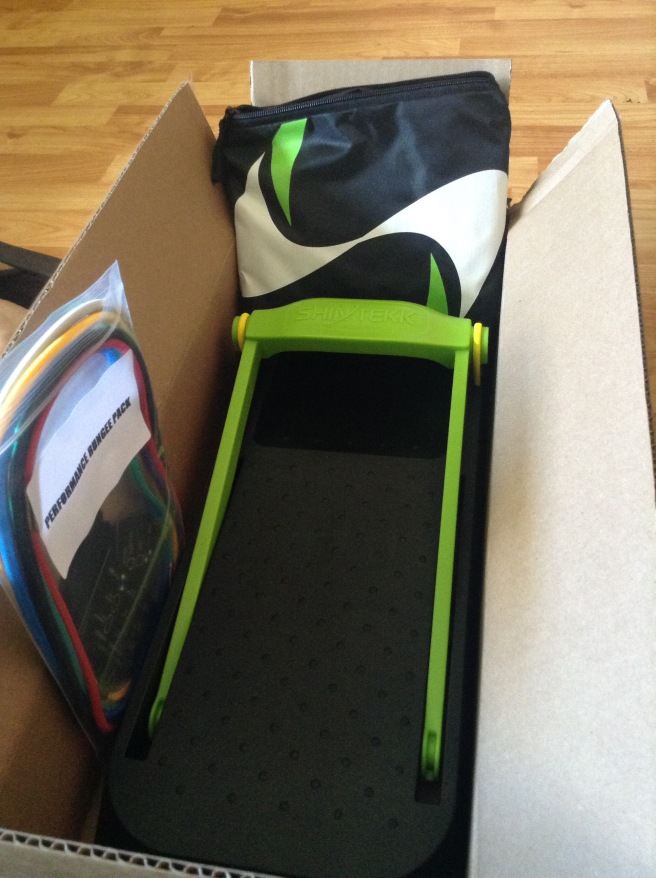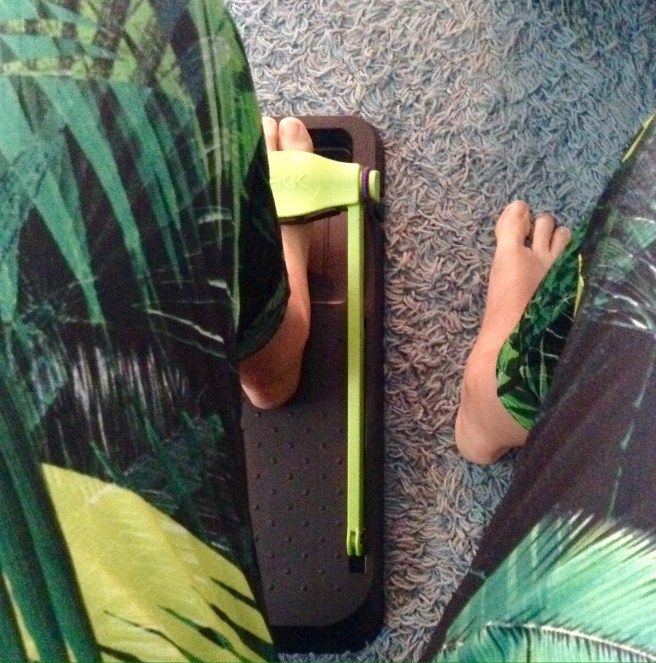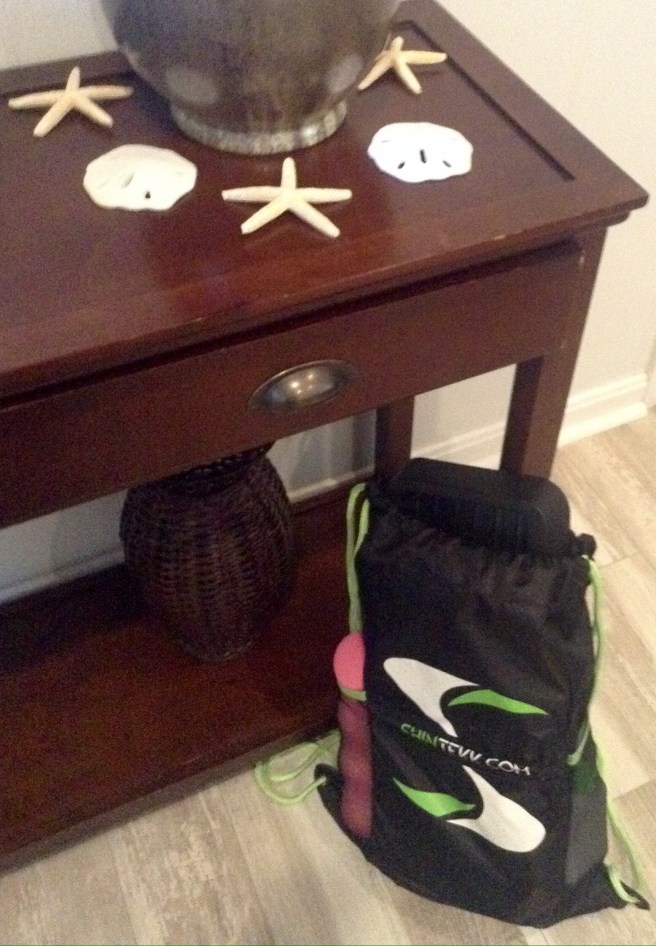Wouldn’t it be great if some fairy godmother came to you and gave you something that took away the pain (whatever pain you might be experiencing)? I feel like that’s what happened to me when the folks at ShinTekk reached out to me and asked if I wanted to review it.
I love to try things, but I explained that I don’t suffer with shin splints. I have, however, been suffering with an achy ankle for months. I’ve seen my chiropractor and a physical therapist about it. I’ve tried new DVDs devoted to foot strength. For a while I taped it.
Everything helped, but nothing took the pain away, until I started to use the ShinTekk.

What is the Shin Tekk?
It’s a very simple contraption.There’s a plastic bed that has a trough at one end; you put your foot into that trough. There’s a small bar above the trough; your toes go underneath the bar. There are handles attached to the bar, and bungees attach to the handles.

You simply place your food on the bed with your toes in the trough, underneath the bar, with or without shoes, and lift. That’s it. You can either raise and lower the bar, or raise it, hold, and then lower it.
There are a number of bungees that come with the Shin Tekk, going from very light resistance to very strong resistance. I started with the lightest bungee and changed it each week to the next strongest bungee.
Did it help?
The answer seems rather obvious from my opening paragraph, but here’s the thing: the chiropractor helped — but it was temporary.
The physical therapy helped, and I did it religiously for months. I still do some of it, sometimes. It added at least a half hour, I’d say, to every day.
The DVD I bought helped, too. I did it religiously for a while, too.
But nothing made my ankle feel normal.
The very first week I used the ShinTekk, even on the lightest bungee, I felt relief, but I won’t lie: after my 10 miler that first weekend, my ankle ached fiercely. After my 10 miler the following weekend? Nothing. My ankle felt normal.
Even the ShinTekk hasn’t made my ankle completely normal — but it almost has. Most of the time it’s just fine. It still aches, a little, on and off; usually wearing compression socks for a while deals nicely with that, but I no longer have to live in them as I did for a long time (which was nice in our hot summer).
The best part? Using the ShinTekk only takes about 5-10 minutes — it’s super simple to add to your running routine.
A little Q&A with Shin Tekk
I had a few more questions before I wrote this review, and here they are:
I read about how/why ShinTekk was created, but what sort of background (aside from being runners) do the inventors have?
Paul and Charlie are machinists by profession and inventors at heart. For the ShinTekk, Paul and Charlie worked closely with other runners, coaches, podiatrists, and physical therapists to ensure the effectiveness of the ShinTekk for runners who love running.
What sparked the idea for this design?
Really, the idea for the ShinTekk was sparked by a problem. Charlie was having trouble with shin splints and went to physical therapists for help. He was prescribed to do resisted toe raises, but he found the methods using resistance bands (or even loaded paint cans) to be difficult and inefficient. He just thought there must be a better way to accomplish the exercise, and here we are!
What sort of runner problems (aside from shin splints) can the shin tekk help with?
So something we always convey to runners is that the ShinTekk is useful for more than just helping to pre-hab or re-hab shin splints. The strengthening exercise the ShinTekk provides improves running performance overall. Strengthening the muscles that control the movement of the foot help the leg bear the load forces that come with initial contact, braking/absorption, and midstance steps of the gait cycle.
Coming back to injury prevention and rehab, the resisted dorsiflexion exercise also strengthens the ligaments of the ankle. This helps prevent ankle sprains and other overuse ankle injuries. For runners this is very important and is one of the reasons why the ShinTekk is also immensely beneficial for use in other sports that involve running like basketball, soccer, tennis etc. (and seems to have definitely helped my ankle problem — most likely an overuse injury).
Is it better to use before or after exercise, or does it matter?
The ShinTekk can be used before and after exercise. Many run coaches we work with like their runners to use the ShinTekk as part of warm-up routines. Some choose to use it as a post exercise cool-down. Mostly, runners use the ShinTekk as a cross training tool, dedicating exercise time on non-run days along with other strengthening and flexibility exercises. (I had been using it post run, but recently switched to pre run — when I can. I haven’t been doing it long enough to report if it makes a difference).
Is there an optimal number of times per week to use the Shintekk?
You can refer to the Workouts section on our website which provides training routines for beginner and advanced athletes. Each suggested workout routine has different goals and optimal uses per week.
This one might be just for me: what can I do when I’m traveling and unable to bring my Shintekk with me?
An exercise commonly done is toe taps. Essentially, in a seated position, you pretend you’re tap dancing and kind of tap the balls of your feet to the floor while keeping your ankle planted. You can find many simple exercises and stretches for lower leg health online, but they can only go so far. Maximizing the benefits of lower leg strengthening really requires a tool like the ShinTekk to make sure the exercise is targeted and an efficient use of time.
Can you overuse it?
As with any training tool, if you begin to feel pain or strain you should immediately refrain from exercise and seek help from your healthcare provider. That said, many of our runners find the workout highly engaging without any sort of strain. The great thing about the ShinTekk is that if you feel like a Resistance Bungee is too challenging, you can always dial it back with a lower tensioned Bungee.
Any other products in the works you can give us a hint about?
We will soon be launching our ShinTekk Foam Roller which many people have been requesting. We’re excited because our goal is to make sure we can provide athletes with a comprehensive set of injury prevention and recovery tools. Myofascial release through foam rolling is an essential part of running.
Any other tips for running injury free you care to share?
Running injury free as a runner revolves around 5 key elements: proper footwear, proper form, flexibility, recovery, and strength. It’s essential for runners to consider each of these elements because they interact with each other as part of your biomechanical chain.
Do the shoes you’re running in fit the shape of my foot correctly? Am I heel striking? Is my body flexible and limbre? (I say body because it’s not just about the legs!) Am I rolling and giving my body time to recover? Are my muscles and ligaments strong enough? The ShinTekk focuses on the strengthening side of injury prevention, but a runner should consider all of these elements together to effectively ward of injury
Disclaimer: I was provided a ShinTekk free in exchange for a review on this blog. The opinions expressed in this post are my own.

Would I buy a ShinTekk?
I will be the first to admit: if I had looked at the Website and seen the price tag, no way would I have bought the ShinTekk. Having used it for approximately six weeks? The answer is a resounding yes!
ShinTekk has made a huge difference in my ankle; everything else I tried helped, but nothing helped as much as using the ShinTekk. It’s worth every penny if you suffer with lower leg, ankle, or foot pain and I highly recommend it.
I can’t, however, address shin splints or plantar fascitis, as I don’t suffer with those conditions (knock on wood). My guess is that ShinTekk would help — immensely.
My ShinTekk did arrive with the handy backpack — it was cool that it zips into a little bag, but frankly, the backpack is where my ShinTekk lives. It traveled with me all summer long: on numerous trips to my parents and our trip to Cape Cod. The backpack made it easy to take with me — and was roomy enough to also accommodate some soft weights, Ooofos, water bottles, and my worm (amazon affiliate link — another tool I highly recommend).
I’m linking up with with MCM Mama Runs, Marcia’s Healthy Slice, and My No Guilt Life for the Tuesdays on the Run linkup.


Fantastic review Judy! Love the questions at the end. If a product comes into existence to solve a problem it’s just great. Fortunately I don’t have any leg issues, but it sounds like a great tool in case this ever changes. Super happy for you that it works and that it found you!
LikeLiked by 2 people
Nice review. I’m great that it cured your ankle issues.
I’m not one for buying exercise stuff – I don’t even have weights or a foam roller. But it’s sounds like a good one for those that do and have shin or ankle problems.
LikeLiked by 2 people
I’m glad it’s helping you!!! You’re reminding me that I need to break this out and use it: http://www.afx-online.com/ 😉
LikeLiked by 2 people
Glad it’s helping you! I’ve not heard of this before! For me, shin splints always mean I’m either in the wrong shoes, or my shoes need replacing!
LikeLiked by 2 people
This looks really cool! I have had some shin irritation in my right shin and I’d be curious to try something like this to help with strengthening. I’m glad to hear it’s worked so well for you!
LikeLiked by 2 people
Glad to hear that has been helping you. I have never heard of that tool. Luckily I have never had shin splints but sounds like it would be helpful in other ways as well.
LikeLiked by 1 person
That is awesome it worked so well and you did not have to buy it! Anything that works the ligaments and will strengthen or stretch the foot is good for the whole chain. I am starting to do a lot of calf raise and forefront raises again- I couldn’t do it for a long time because of the pain.
LikeLiked by 2 people
That’s great that you can do that now-especially with marathon training!
LikeLiked by 1 person
Fabulous! I may have to look into it!
LikeLiked by 2 people
It has definitely helped me a great deal.
LikeLiked by 1 person
Is there any research behind this product and the claims?
LikeLike
You would have to contact the company to get an answer, as I am not affiliated with them – shintekk.com.
I am not a scientist and can only offer my own anecdotal experience, which was extremely positive. The ShinTekk allowed me to run without ankle pain for the first time in months — physical therapy had helped, but I was still dealing with ankle pain.
I believe that many runners would benefit from the ShinTekk, but no, it’s not something I can prove.
LikeLike